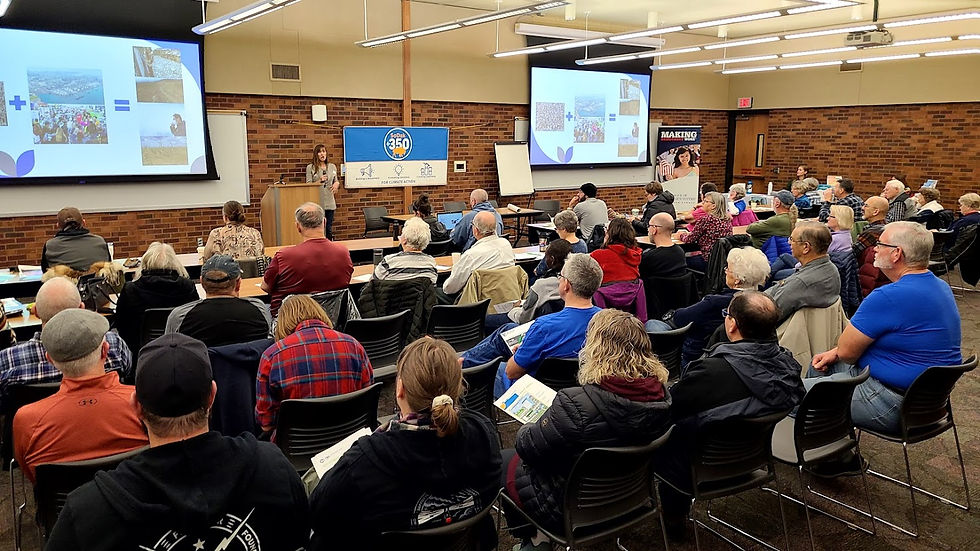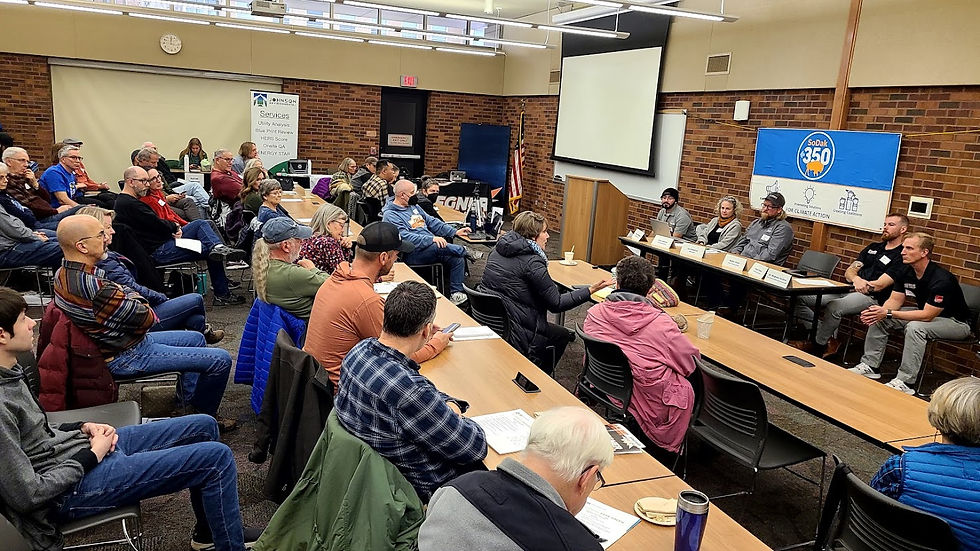Go Green to Save Green: From federal policy to local opportunity
- Kara Hoving

- Nov 23, 2022
- 5 min read
Updated: Jul 26, 2023
“Go Green to Save Green” forum explores how new Inflation Reduction Act programs can help South Dakotan communities chart a path to a sustainable future

On November 12, SoDak 350 hosted its first “Go Green to Save Green” educational forum in downtown Sioux Falls. Catalyzed by the passage of the Inflation Reduction Act earlier this year, this half-day event centered around exploring opportunities for residents and businesses to cut down their energy costs and tax payments by taking advantage of new federal incentives for green and energy-efficient technologies.
At the event, a panel of local experts in the energy, building, and automotive industries fielded questions from over 50 attendees about the costs, savings, benefits, and challenges involved with switching to sustainable technologies like solar panels, electric vehicles, smart meters, and better home insulation and energy efficiency. Attendees were able to ask detailed questions about what this transition might look like for their household. But simmering under the surface was a broader discussion about what the new federal incentives might look like for Sioux Falls, and what changes are still needed to get South Dakota on the path to a sustainable future for all.
Emphasizing opportunities
Dr. Meghann Jarchow, Associate Professor and Chair of the Department of Sustainability and Environment at USD, opened the event with her keynote presentation “The State of Sustainability: Opportunities for Our Region.” Dr. Jarchow emphasized the need to shift the narrative on sustainability and the environment from one of doom and gloom, guilt, and shame to one of hope and opportunity. Sustainability, ultimately, is about asking the question: what kind of world do we want, and how can we effect change to create that world?
To achieve this vision of the world we want, we need to embrace complexity and view the world in terms of interconnected systems, collaborate along common ideas and values, and embrace opportunities for innovation and entrepreneurship. Recalling the old adage of “think globally, act locally,” Dr. Jarchow emphasized the importance of being globally informed, but taking action in the places we know and care about: “When we know the local context, we are more able to make change in a way that is just and responsible and effective.”
Enabling self-sufficiency and resilience
For South Dakota, place-based solutions could include restoring drained wetlands and rehabilitating depleted soils to sequester and store carbon, generating revenue through global carbon markets. These solutions could also help South Dakotans adapt to ongoing changes in the regional climate by absorbing excess water from increased winter and spring precipitation, reducing the risk of floods and retaining water in local watersheds for use during summer dry periods. Longer growing seasons could also allow farmers to switch from growing row crops like corn and soybeans - which primarily are used for fuel or livestock feed - to growing food for people in regenerative systems. Finally, South Dakota has enormous wind energy potential - with wind resources ranging across the state from “fair” to “outstanding” - as well as good potential for solar energy. With these opportunities at hand, South Dakota has the potential to become mostly food, energy, and material self-sufficient while building a regional economy that is more profitable and resilient.
Drawing on this ideal of self-sufficiency - a virtue that many South Dakotans pride themselves upon - could be an inroad towards driving more people to invest in green technologies like solar panels for their own households. Adam Fischer and Hunter Clanin of Wegner Roofing and Solar emphasized that rooftop solar allows households to “own their own power” instead of “renting” it from utilities. Not only does this allow households to dramatically cut their energy costs, it allows them to continue to independently produce power during grid outages, making them more resilient to extreme weather events. Community solar and microgrid projects - which allow businesses and residents which may not have been able to purchase solar panels on their own to invest in and receive power from a shared solar array - can spread these benefits to the scale of a whole neighborhood.
Similarly, home energy retrofits, which are incentivized through multiple tax credit & rebate programs in the Inflation Reduction Act, allow households to update things like windows and insulation to improve the energy efficiency of their homes, reducing energy costs and reliance on utilities while allowing the home to better maintain a comfortable temperature in the case of an outage.
From left: Hunter Clanin, Regional Solar Specialist at Wegner Roofing & Solar, discusses opportunities for residential solar power; Ian Kumerow of Billion Nissan answers questions about electric vehicles; Arlene Brandt-Jenson, Administrative Coordinator at SoDak 350, gives an overview of the Inflation Reduction Act
Catalyzing local action
The recently passed Inflation Reduction Act (IRA) - as well as the bipartisan Infrastructure Investment & Jobs Act of 2021 and the CHIPS and Science Act - introduced a flood of new grants, rebates, and tax incentives for everything from solar panels and home energy retrofits to electric cars, stoves, and clothes dryers, with an emphasis on making green technologies affordable and accessible for low- and middle-income families. Rewiring America - a national energy efficiency organization - estimates that with the host of new programs rolling out over the course of 2023, the average household could qualify for over $14,000 in rebates and tax credits and save $1800 per year on energy bills. (This online calculator allows households to estimate their eligibility and potential savings).
Despite this upcoming influx of resources, in some cases local and state-level changes are still needed before some households can fully take advantage of the funds. For example, the IRA includes $7,500 tax credits for new (and $4,000 for used) electric vehicles (EVs), but installation of EV chargers throughout the city will need to accelerate to accommodate increased demand - especially for renters who park in shared garages and may not be able to charge at home. According to Chris Johnson of Johnson Environmental, updating the city’s building codes to the most recent International Energy Conservation Code standards would require all new commercial construction to have at least 3% of parking spaces equipped for charging. The city could also invest in pilot charging projects at city buildings or parking meters.
As another example, South Dakota is one of the only states in the country without a statewide net metering policy. Net metering allows households with solar panels to take any excess energy they produce and sell it back to the grid at a fair rate. This manifests as a credit on the household’s monthly energy bill, allowing the household to further decrease their energy costs or even make money. For many families, net metering could tip the scales in favor of affording solar by cutting down the payback period of the solar system. But without a statewide net metering policy, households are left to the whims of their utility, most of which compensate for excess solar energy at a rate far below the market price of electricity. Adopting some sort of net metering rule would allow many more households to take advantage of opportunities to produce their own power. It is crucial, then, that South Dakotans make their voices heard to officials in Pierre and at the local level, and advocate for policies that will create an enabling environment for individual action.

Expanding outreach and education
Finally, both speakers and attendees at the event emphasized the need for more education and awareness building. “Small communities across South Dakota have a lack of information - they really need to hear things like this,” remarked one audience member. Having conversations about clean energy opportunities across the state - appealing to shared values and employing the language of innovation and entrepreneurship - could help create momentum for South Dakota to begin working to build the kind of world we all want to see.









Comments